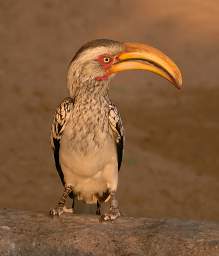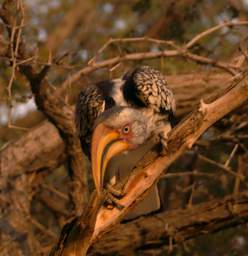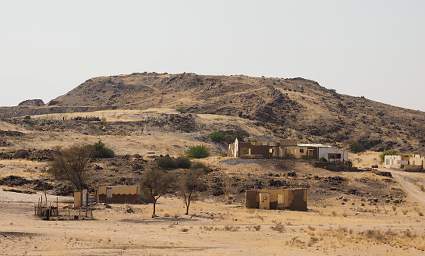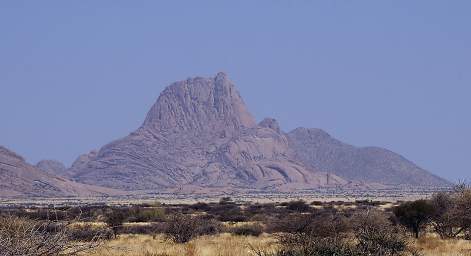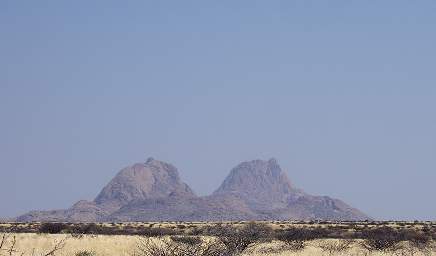Brandberg Mountain Nature Reserve
Hot and Full of Ancient Art
August, 2014
Click on any image for a larger view;
Contact garya at this domain if you would like the high quality image for printing
Since we didn't have time to visit all of the parts of Namibia we wanted to,
we were forced to pick and choose.
Distances are great, and much as we wanted to revisit the Namib-Nukluft area
and see the Fish River Canyon area, we simply didn't have time.
The Brandberg Mountain Nture Reserve is located in the northwestern part
of the country,
and is known as an area of early human art -- pictographs and petroglyphs.
In addition, it has lots of places to hike and generally roam about.
Unfortunately, most of those places require a 4WD vehicle to get to.
However, some are accessible by normal 2WD vehicle,
and as in most of Namibia, there are great campgrounds for economical visiting.
We decided to stop and explore a bit and hike up to the "White Lady,"
the most well-known early artwork in the area.
We stopped for supplies in Xxx, the only large town on our way.
The northern part of Namibia is very diverse,
and we encountered a wide range of people as we wandered around town shopping.
I got a kick out of seeing what looked like comfortably dressed children
in the company of their not-so-comfortably dressed Herero mothers.
Sometimes it seems that while the place changes, the situation often doesn't --
think of women in tight skirts and high heels in the U.S.,
or New Yorkers in suits and ties in the sweltering summer heat.
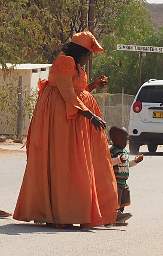 |
| Herero Woman |
Brandberg Mountain is the highest mountain in Namibia,
and the massif dominates the entire area.
It is an imposing hunk of rock.
When you consider the extreme climate and the refuge the mountain offers,
it's no wonder the area is littered with evidence of early human habitation.
 |
| Brandberg Mtn |
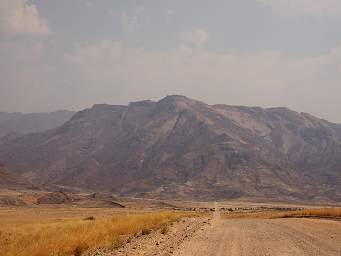 |
| Brandberg Mtn |
It's a long way between settlements in this,
and indeed in almost any, part of Namibia.
We encountered people walking and traveling by cart from one place to another,
often on what must have amounted to an all day journey.
Sometimes we saw people going short distances dragging a stoneboat or sled;
sometimes they had a proper horsecart made from scratch;
but often they used a cart like the one below,
made from the rear end of a car --
a design you see the world over, from under-developed countries to highly developed ones.
In the United States, these carts take the form of trailers towed behind vehicles;
in Namibia, they take the form of donkey carts.
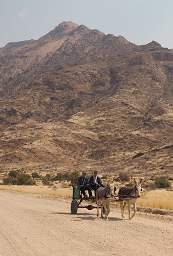 |
| Donkey Cart |
We drove to the trailhead for the hike to the site of the "White Lady" pictographs,
where we were required to hire a local guide.
Dona made sure she had her hiking poles,
and we made sure our water bottles were filled.
It was not the best time of day to be hiking -- early afternoon, and it was still pretty warm.
As Dona puts it, our guide recognized he had some geezers and tactfully navigated a path from shade tree to cliff-shade
to shade tree, pausing in the shady spots for relief and to talk about the environment and the history of the area.
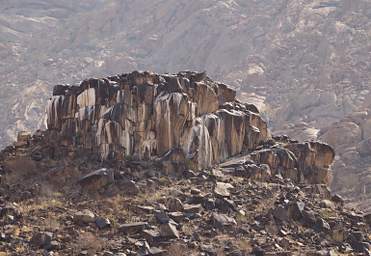 |
| Columnar Rock |
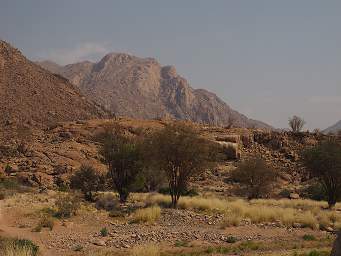 |
| Brandberg Mtn |
As usual, we were on the lookout for tenebrionid beetles,
and as usual, we found some.
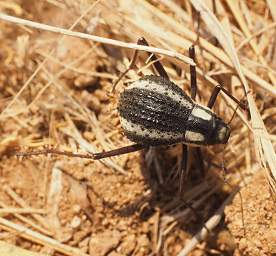 |
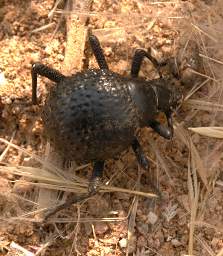 |
| Tenebrionid Beetles |
I was not surprised that we were hiking up a creek bed,
but I really was surprised to see that the creek had actual water flowing on the surface.
I expected there to be water, but only at the head of canyons where it was more shaded.
It's easy to see why the area is full of evidence of early human inhabitants,
if it has surface water in this kind of heat.
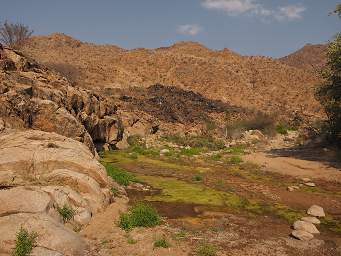 |
| Brandberg Mtn Creek |
There were several different plants with blooming flowers;
most, as usual, sporting formidable thorns.
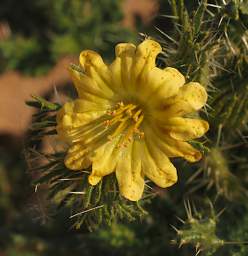 |
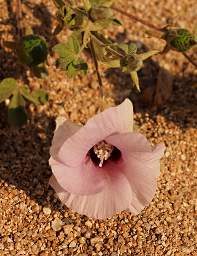 |
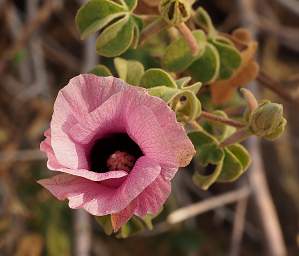 |
| Flower Xxx Yellow |
Flower Xxx Pink |
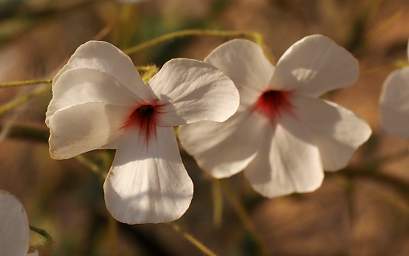 |
| Flower Xxx White Pink |
As with mny desert areas, anywhere a seed could lodge and some moisture could be captured,
something grew.
Despite looking like a barren hunk of rock,
there was a lot of plant life tucked here and there.
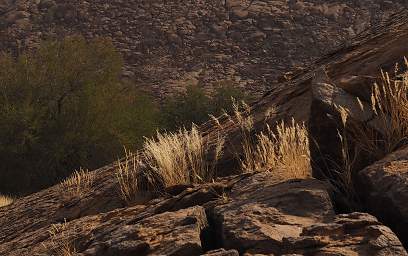 |
| Grass in Rock |
And wherever there are plants,
there are sure to be adapted animals.
The creek bottom was especially lively, as at this particular point in time there were a lot of plants
bending over from the weight of seeds,
and the local residents were busy harvesting them.
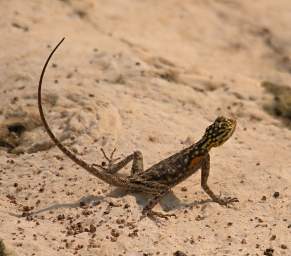 |
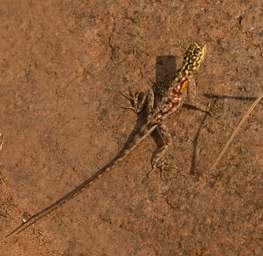 |
| Rock Agama (Female) |
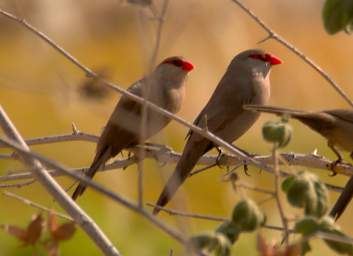 |
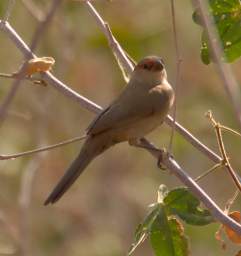 |
| Common Waxbill |
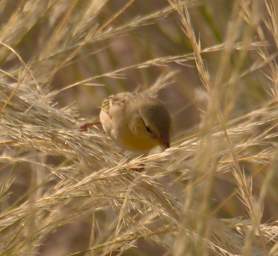 |
| Bird Xxx |
There were a fair number of baboons in the nearby rocks,
staring down at us.
They didn't seem so used to people that they would become a nuisance,
but they didn't seem very concerned for their own safety either.
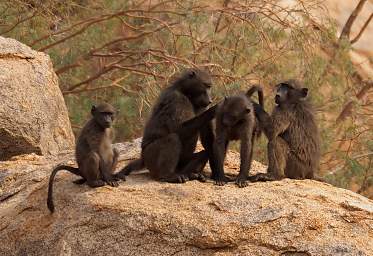 |
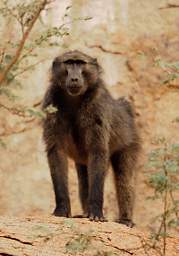 |
| Baboons |
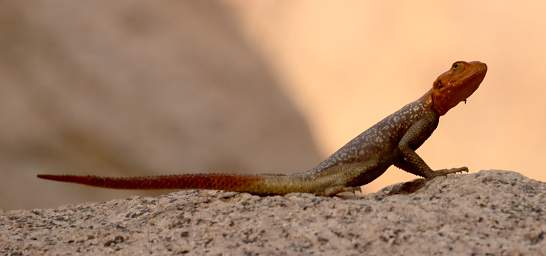 |
| Rock Agama |
The actual pictographs with the White Lady are in a protected area under an overhang,
but have been protected further by a man-made shelter.
It is a quite extensive "mural" which has been added on to by various people over many centuries and millenia.
Interestingly, the "White Lady" is an image of a person who is neither white nor female,
one of those unfortunate historic names which stuck.
 |
| Pictographs, White Lady |
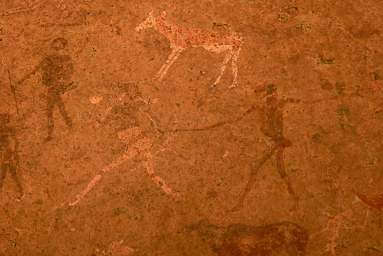 |
White Lady
well actually, a Black Man |
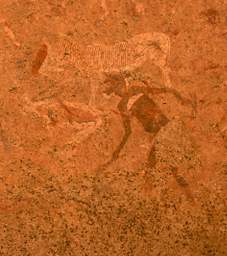 |
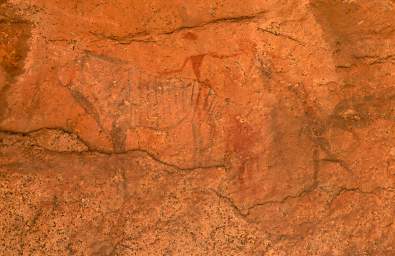 |
| Pictographs Below Left Of White Lady; Zebra |
Zebra |
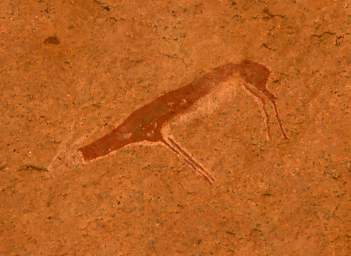 |
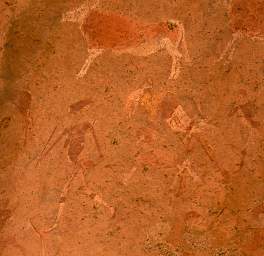 |
| Pictographs |
Other (actual) Lady and Cows |
The site of the White Lady is a few kilometers up the valley;
by the time you get there, the creek has dried up, or at least disappeared underground.
The creek bed was fun to look at, and imagine flowing with water during the rainy season.
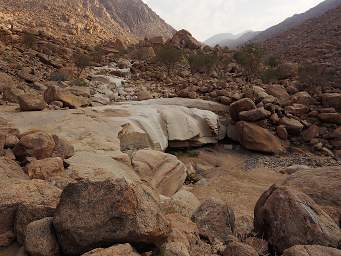 |
| Creekbed |
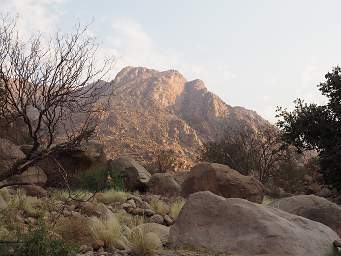 |
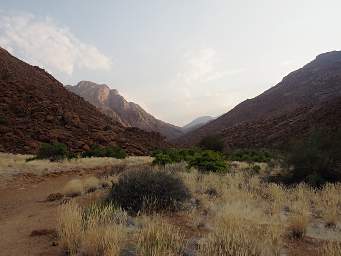 |
| Brandberg Mtn |
After our hike we headed for a campground.
We ended up at a large one with nice shade that was part of a fancy some-number-of-stars lodge.
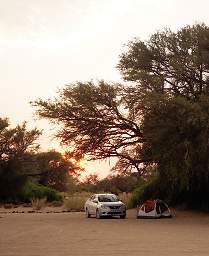 |
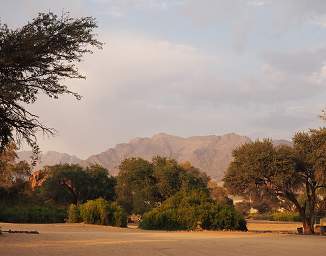 |
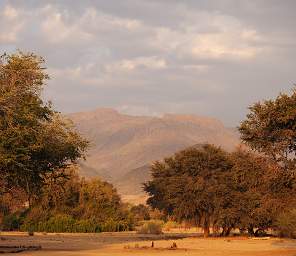 |
| Our Camp |
Brandberg Mtn. from Camp |
There is still quite a bit of tent camping in Namibia,
which makes it a delightful place to travel.
You don't see much in the way of mega-winnebagos.
Instead, you see vehicles carrying people and actual camping gear.
Sometimes we would see a large vehicle like a bus,
and when it would stop a small army of people would emerge and tents would spring up in a dense little village.
Other small vehicles like ours would produce regular tents.
Many are some form of tent-trailer,
or tent which is pitched on the top of the vehicle.
The advantage of the latter is you at least feel a bit removed from
things like snakes and lions.
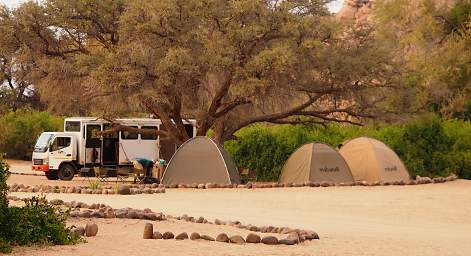 |
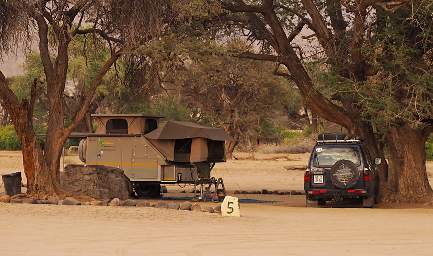 |
| Monster Camp |
Trailer Camp |
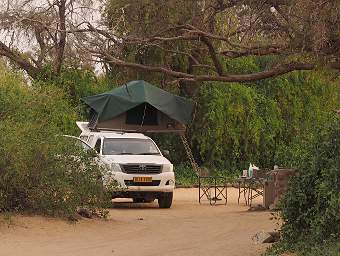 |
| Popup Camp |
The campground had nice hot showers which we took advantage of,
and an interesting meal-time audience.
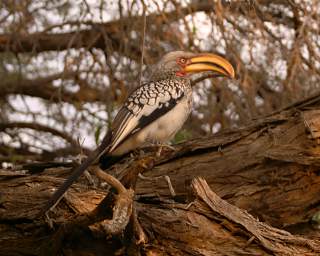 |
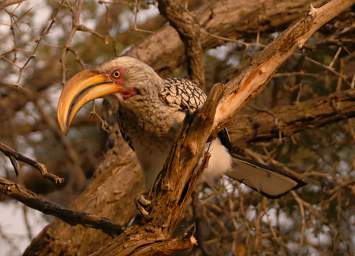 |
| Southern Yellow Hornbill |
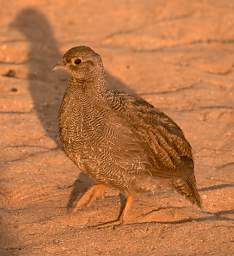 |
| Double Banded Sand Grouse (Female) |
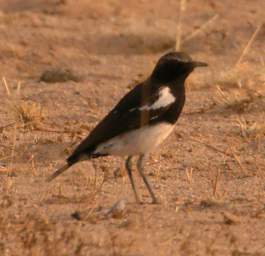 |
 |
| Mountain Wheatear |
Our camp was situated along a dry riverbed;
the main lodge was a bit further away,
backed into a small hill with a tremendous view of Brandberg Mountain and the surrounding area.
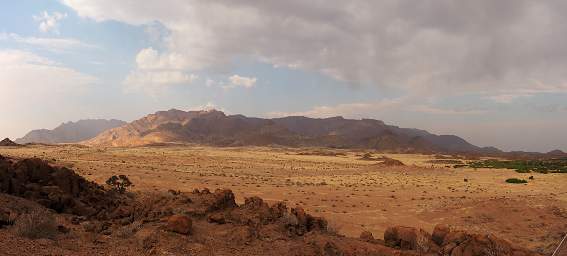 |
| Brandberg Mtn |
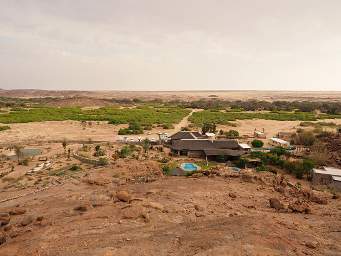 |
| Brandberg Mtn Lodge |
As we drove out in the morning, we passed one of those incongruities of Namibia --
a simple dwelling with stick sides and a galvinized steel roof,
with a late-model vehicle parked in the back.
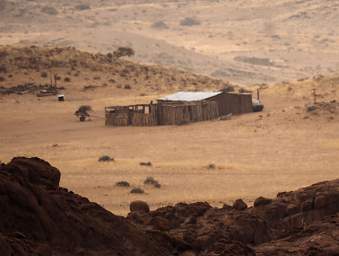 |
| Car Behind House |
The plain was filled with prototypical African savannah kopjes.
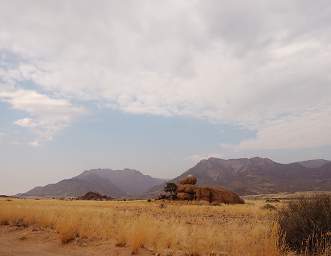 |
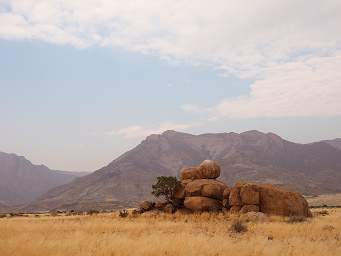 |
| Kopje and Brandberg Mtn |
And then, no real surprise but seemingly a long ways from anyplace,
young kids in charge of a donkey cart, heading... somewhere.
They seemed as interested in us as we in them;
if we had been walking,
perhaps we would have all stopped and learned more about each other.
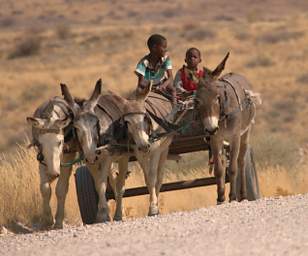 |
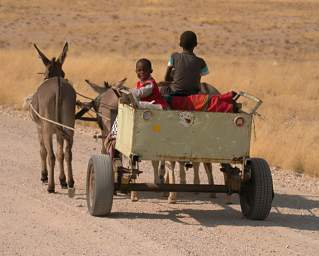 |
| Two Boys on a Donkey Cart |
It was always a treat to discover some strange bird wandering around out in the grass,
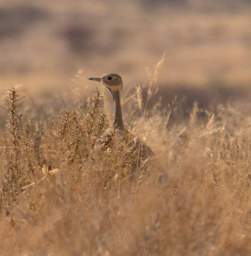 |
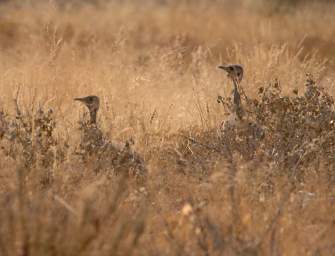 |
| Xxx Korhaan |
We passed a number of what looked like abandoned towns,
but sometimes it was difficult to tell if they were actually abandoned.
In this very poor country,
my eye has difficulty discerning the difference between abandoned,
seasonally used,
and unoccupied at this particular moment.
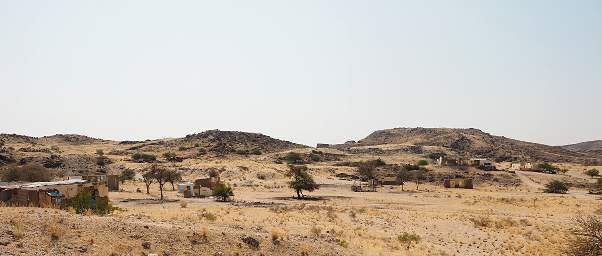 |
| Abandoned Town |
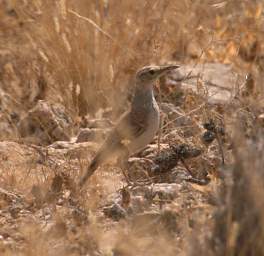 |
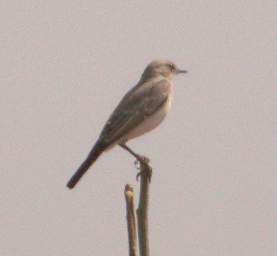 |
| Benguela Long Billed Lark |
Bird Xxx |
I learned, late in the game, that
one of the things we were looking for was gems, or at least interesting rocks.
We were heading to a town where our guide book said there was a great shop with a knowledgeable proprietor,
so when we passed this road in the middle of nowhere heading to more middle of nowhere,
we didn't even consider going down it.
Even with its sign saying "gems" painted on a rusted out 55 gal drum lid.
I still regret not taking the time to head down that clearly much less traveled road.
Who knows what we might have found,
what fun we might have had,
and what interesting people we might have met.
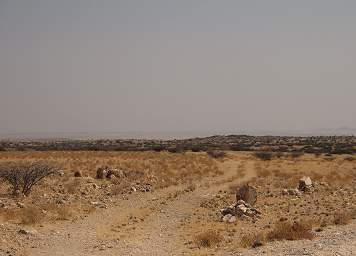 |
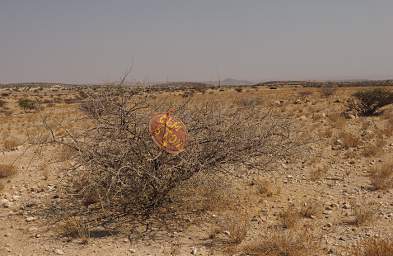 |
| Gem Stones Road |
Gem Stones Sign |
One of the things I wanted to see was this hunk of rock sometimes referred to as the "Matterhorn of Namibia,"
but formally known as "Spitzkoppe."
I suspect that means "pointed kopje" in Afrikaans.
It was difficult to imagine,
as all we had seen so far in Namibia was large expanses of desert and sand,
flat plains,
bands of cliffs like the Waterberg Plateau,
and now Brandberg Mountain which is more a large pile of eroded jumbled rock,
But then there it was,
sticking out of the plain like it had been plopped down as part of a giant diorama.
It looked like a nice hunk of rock, with interesting route possibilities of varying difficulty.
It is apparently a challenging climb,
made more so by the extreme heat and lack of water.
It looked like fun to me,
but I was here without a climbing partner, no gear, and no time.
Pooey.
I should have come here forty years ago...
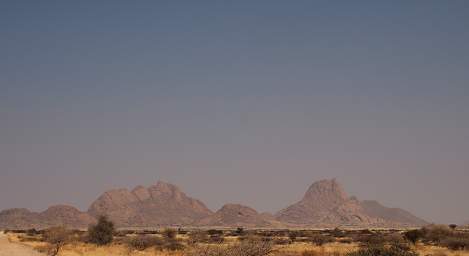 |
| Spitzkoppe |
We left Spitzkoppe and continued on our way,
looking for a last campground before we returned to Windhoek the next day.
Our town with the gem shop was a disappointment,
as we were there on a Saturday
and despite being high tourist season, it was closed.
We ended up driving much of the way back to Windhoek,
spending the night in an uninspiring campground.
But before we got there we traversed some rugged,
lightly inhabited country that once upon a time had been home to some of Namibia's pround native people,
but was now mostly large ranches owned by descendants of European settlers.
 |
| Beetle |
 |
| Outcrops |
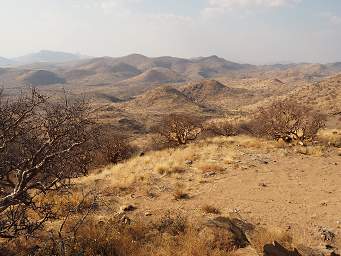 |
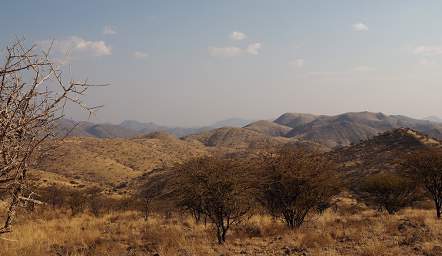 |
| Bosua Pass |
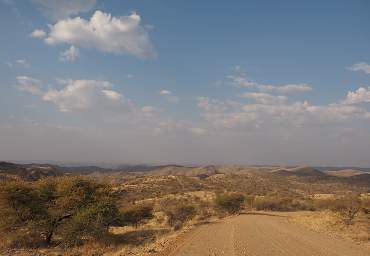 |
| C28Country |
Then we returned to Windhoek,
where we returned Bret's borrowed camping gear,
our rental car,
and then boarded the plane for home.






































